Eddie Van Halen took the ergonomic playability and lightweight body of the Fender Stratocaster and introduced the aggressive, broad tone of the Gibson Humbucker pickup. He re-routed the guitar’s cavities, placed a quarter under the tailpiece to assist in his whammy bar abuse, and bypassed every control on the instrument except a single volume knob. The “Frankenstrat” was the first of Van Halen’s guitar technology innovations, but it was by no stretch of the imagination the last. The journey started in 1978, but it continues to this day.
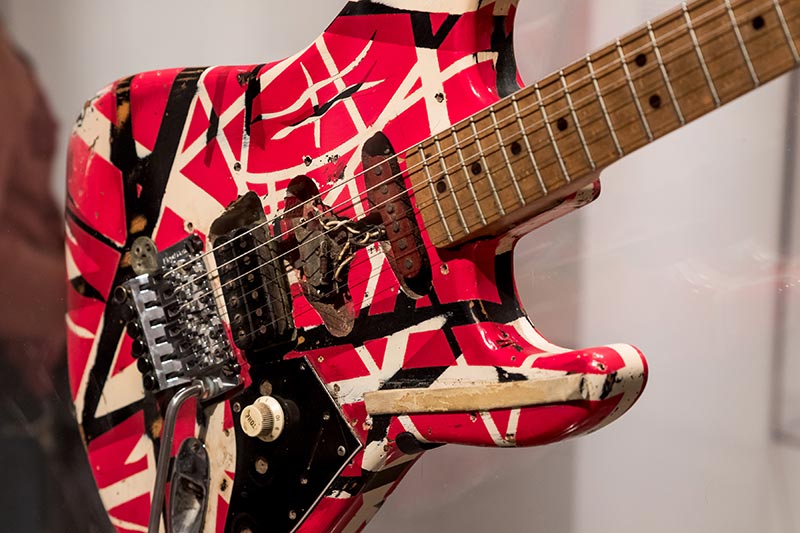
Today, the EVH brand adorns strings, picks, leads, amplifiers, and, of course, guitars. The EVH range is produced in several factories all over the world, with various models based on Eddie’s own guitars and preferences available. Eddie Van Halen remained heavily involved in the EVH brand until his death, refusing to stamp his name on anything that failed to meet his high standards.
Let’s take a look at who makes EVH guitars, where EVH guitars are made, and what sets this brand apart from the countless shred guitar models on the market.
Who Makes EVH Guitars?
Fender makes EVH guitars. However, the EVH brand has a relationship with Fender every bit as unique as Eddie Van Halen himself.
These days, the EVH brand is owned by Fender Musical Instruments Corporation or FMIC. FMIC is a privately-owned company based in Scottsdale, Arizona, and was initially founded by Leo Fender way back in 1946.
Although Fender is the name of the company, the Fender brand owns many other guitar brands, including Gretsch, Jackson, Charvel, Squier, and EVH.
Eddie Van Halen’s stature and public profile made him a highly lucrative endorsee for countless guitar brands. From the 1990s up until 2004, Eddie Van Halen worked closely with Peavey guitars to produce his signature line of amplifiers and guitars. However, at NAMM 2007, Fender announced a then-unprecedented partnership with the Van Halen brand. Fender went above and beyond any deal offered to an artist beforehand, offering not only guitars or amplifiers but an entire brand of Van Halen’s own. This was the genesis of the EVH brand.
Initially, Fender’s partnership with Eddie Van Halen was limited to the Charvel-produced Striped Series, a line of single-pickup Superstrat guitars based on the homemade instruments Van Halen played during the 70s and 80s. However, upon the launch of the EVH brand, Fender expanded their approach, starting with a signature line of amplifiers built to Eddie Van Halen’s own exacting specifications.
The EVH acronym was widely used before the Fender partnership for Van Halen’s signature line of guitars and amps produced by Peavey. Primarily, this referred to the Peavey 5150 amplifier and the Peavey EVH Wolfgang.
Who Makes EVH Wolfgang?
Fender makes the EVH Wolfgang model, which is one of the EVH brand’s premier designs. With its distinctive body shape and cutting-edge technology, it might not be the most famous Eddie Van Halen guitar, but it is the instrument that epitomizes Eddie Van Halen’s “endless pursuit” of tone.
In fact, Eddie himself said of the Wolfgang model “I seem to always be refining the design. I’m constantly putzing around with it. You go on tour and you realize what works and what doesn’t work. It’s an endless pursuit.” The first iteration of the Wolfgang, as it’s now known, was initially produced by Ernie Ball Music Man as can be seen in the image here.
Eddie designed this guitar, with its basswood body, flat maple top, DiMarzio pickups, and solitary volume knob, erroneously marked “tone”. Of this feature, Van Halen said “when you turn it up, you get volume and you get a nice tone. How many people do you actually know that even touch the tone control on a guitar, anyway? On a bass, maybe, but not on a guitar.”
The Music Man Eddie Van Halen guitar was the first version of the Wolfgang, and it hit the market in 1991. It wasn’t long, however, before this partnership came to an end, and Van Halen redesigned the instrument with Peavey, who he had previously worked with on the 5150 amp series.
The Peavey Wolfgang was the first to bear the name of Van Halen’s son, and the now-familiar EVH logo. The Peavey-Van Halen partnership first hit the market in 1996.
This was simply an additional “signature”, as the guitars still bore the Peavey logo and branding. Modern Fender-built EVH guitars only show the EVH logo.
These USA-made guitars persisted until the end of Van Halen’s Peavey deal in 2004.
All Wolfgang models produced between 1996 and 2004 were made by Peavey, while all EVH Wolfgang models made since were made by Fender under the EVH brand. The biggest difference here is that Fender’s engineer and Eddie Van Halen worked closely to redesign the Wolfgang yet again upon the legendary guitarist’s arrival at Fender.
Van Halen plays the Peavey Wolfgang in the below video from 1998.
Although the EVH-Fender partnership first came about in 2005, it wasn’t until 2009 that EVH started producing the Wolfgang once more. Fender’s Chip Ellis recalls redesigning “about 90 percent” of the existing Wolfgang features, down to the thickness of its top and the screws keeping the instrument together. Supposedly, Ellis and Van Halen spent around a year testing pickups for the new Wolfgang, including sets from Seymour Duncan and DiMarzio. Eventually, they settled on building new pickups from scratch in-house at Fender, creating yet another EVH product.
The EVH Wolfgang line is still produced to this day, and all Wolfgang guitars are built in one of three factories owned by Fender.
Where Are EVH Guitars Made?
EVH guitar models are made in 3 primary factories located in the USA, Mexico, and Indonesia. Modern guitar companies benefited as much from globalization as shipping companies and manufacturers.
It’s far cheaper to make most products in some countries than others, and even the art of building a Van Halen-approved guitar can be outsourced to the Far East. The EVH brand is no exception to this rule, although like many other Fender brands its guitars are produced all over the world. The greatest hint as to the birthplace of a particular guitar is its price point, and generally speaking, EVH guitars are priced (and named) according to their place of origin.
The flagship EVH model, first introduced in 2009, was the EVH Wolfgang USA. This radically redesigned Wolfgang guitar was built by Fender in Corona, California. Any EVH guitar bearing the USA moniker is made in the USA, at Fender’s own factory. These are the most expensive EVH Wolfgang models available, as they are made by Fender’s own master builders using the finest materials and craftsmanship.
Also made in the USA are the iconic Striped Series, which features painstakingly produced replicas of Eddie Van Halen’s own Frankenstein guitar, as well as the black-and-white “Eruption” guitar and the black-and-yellow “Bumblebee”.
On EVH’s website, these guitars are listed as the “tribute” series. These guitars are all built-in Fender’s Corona, California factory, and command prices around $3000 USD or over.
The Striped Series “Shark”, based on an Ibanez Destroyer that Eddie Van Halen modified with a hacksaw, is also a USA-made guitar. It is notable as the only EVH-produced guitar based on a Gibson-style design, that of the Explorer. The original “Shark” initially appeared on the cover of 1980’s Women and Children First.
In a somewhat confusing move, EVH also produces Striped Series guitars built in Ensenada, Mexico, at a Fender-owned factory. A Fender quality control team visits Ensenada weekly to ensure that the factory continues to meet Fender’s high production standards. In fact, Ensenada is only a three-hour drive from Fender’s Corona factory! Mexican production commands a far lower cost than that of California. As a general rule, EVH’s mid-priced guitars are made in Mexico.
These Mexican-made EVH guitars include the aforementioned Striped Series (not to be confused with the replica series), the Wolfgang Special, and the 5150 line of guitars, Superstrat-style instruments that were not played by Eddie Van Halen himself.
Briefly, EVH Wolfgang Special guitars were built in Japan. This period, 2010-2011, saw the Japanese-built Wolfgang Special range feature the same pickups as the USA model. Although this factory closed in 2011, it was the predecessor to the Wolfgang Special line reintroduced in 2014 and built in Mexico, as described above.
Finally, the lowest price point of the EVH range is the Wolfgang Standard. These guitars are built in Fender’s Indonesian factory and accordingly are the least expensive of the EVH range.
Although each factory produces a variation on the Wolfgang, there are notable differences between the various ranges. The same applies to the Striped/replica line of EVH guitars. The EVH 5150 line has not been in production for long enough to determine any future alterations, but contemporary reports indicate that all 5150 guitars are built at the Ensenada factory.
Where Are EVH Amps Made?
EVH amplifiers are manufactured at the Fender factory in Ensenada, Mexico. It has been reported that the earlier EVH amps were made in Vietnam before production shifted to the Mexico Plant.
USA Built EVH Guitars
| Wolfgang Signature Series | Made in USA |
| Wolfgang USA Series | Made in USA |
| Tribute Series | Made in USA |
| Frankenstein and Frankenstrat replicas | Made in USA |
EVH Wolfgang USA Signature Series:
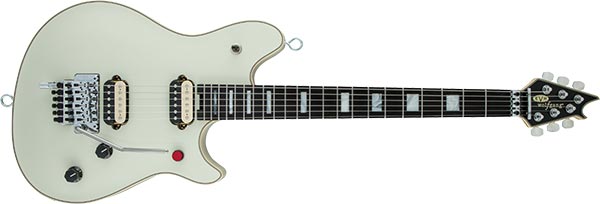
EVH Wolfgang USA Series:
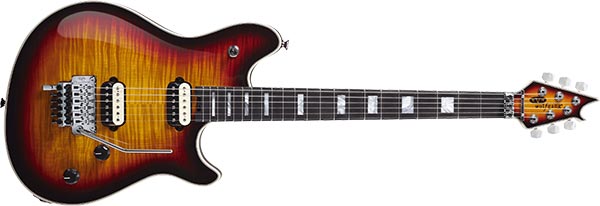
The Wolfgang USA series represents the pinnacle of EVH and Fender’s guitar-making ability. Eddie Van Halen himself played Wolfgang USA and Signature models live and in the studio until his tragic death in 2020.
The USA-made EVH guitars are the premium-priced high-quality template upon which the Mexican and Indonesian guitars are based.
The Wolfgang USA models use a quartersawn maple neck attached to a basswood body, with a gloss urethane finish. The neck is reinforced with graphite, and as of 2021, the USA models are only available with an ebony fretboard. This fretboard is adorned with 22 vintage stainless frets and Pearloid block inlays. The Signature USA model has a maple top, although the lower-priced Wolfgang USA has no maple top.
The USA-built Wolfgang range also features an EVH branded Floyd Rose bridge and tremolo system, R2 locking nut, and the EVH-designed D-tuna, which allows players to switch from standard tuning to Drop D with the push of a button. The tuning heads on these guitars are EVH branded Gotoh tuners and all hardware is chrome.
Van Halen can be seen playing one of his US-built Wolfgang Signature models in the below video from 2015.
EVH Tribute Series:

The Tribute series, which features the Eruption, Frankenstein, and Bumblebee (shown above) models. These guitars were built to replicate EddieVan Halen’s most famous Stratocaster-style guitars. The Eruption and Frankenstein were based on the same guitar but vary only in the paint job, with the Eruption in black and white and the Frankenstein in red, black, and white. All three guitars come with an ash Stratocaster body, jumbo frets, a bolt-on maple Stratocaster neck with an oiled back finish, Schaller tuning heads. These also have the eye-screw strap hooks preferred by EVH himself and EVH pickups. The Bumblebee has a unique EVH Bumblebee pickup, while the Eruption and Frankenstein feature the EVH Frankenstein pickup.
EVH Frankenstein Replica:

The Frankenstein guitar is perhaps the most famous of Eddie Van Halen’s instruments, and several Frankenstrat copies were made over the years. The original guitar, made from an ash body, maple neck, a Gibson 335 humbucking pickup (which was later replaced by a Seymour Duncan). Its original electronic circuit was brutally simple: the humbucking pickup ran through a sole 500K potentiometer and into the output jack.
Kramer and Charvel both produced Frankenstrat copy guitars, although neither with the painstaking level of accuracy enjoyed by the Fender-made Frankenstein copies. Van Halen built a Frankenstrat copy named the 5150 during the Sammy Hagar era. It’s on this Kramer guitar, with its Kramer Pacer body, that the Mexican-made 5150 series is based, albeit loosely.
Mexico Built EVH Guitars
| Wolfgang Special (2014 – present) | Made In Mexico |
| Striped Series | Made In Mexico |
| 5150 Series Standard and Deluxe | Made In Mexico |
EVH Wolfgang Special:
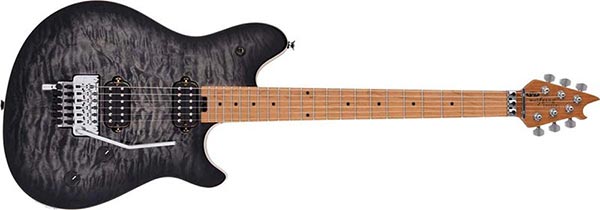
Although these Mexican guitars are more affordable than their US-built cousins, often commanding prices as low as half that of the American-made EVH line, they feature many of the same appointments. Some Mexican-made guitars, such as the Wolfgang Special line, actually have some features not available in the American-made guitars, such as a wider variety of finishes and the choice of maple or ebony fretboards.
The Mexican-made Wolfgang Special range comes with the same EVH Wolfgang pickups as well as EVH-branded electronics, including the 500K EVH Bourns Low Friction Pot with Treble Bleed Circuit, and 250K EVH® Bourns® High Friction Tone Pot. The Special and the Wolfgang USA differ mainly when it comes to the three-way pickup selector, which on the USA model is in reverse as per Eddie Van Halen’s personal preference. With the reverse spec, the first position on the selector only turns on the neck pickup, while the same position on the Special turns on the bridge pickup.
The Wolfgang Special series lacks the block inlays of the USA models, instead, using a dot inlay. Similarly, its jumbo frets are not the stainless steel of the USA model.
EVH Striped Series:

The Mexican-made Striped Series is based on the Tribute series, with a few cost-saving features. The ash body is replaced by basswood, and the period-correct Floyd Rose system is replaced by a modern Floyd Rose R3 system. The brass nut and retainer are also gone, with Floyd Rose nuts instead. Similarly, EVH branded Gotoh tuners replace the Schaller heads on the Tribute series, and the eye hooks are replaced by standard strap buttons. The single-pickup Mexican-built Striped Series only uses Frankenstein pickups, with a sole EVH Bourns Low Friction Pot with a treble bleed circuit.
EVH 5150 Series:

The 5150 series of guitars comes with either ebony or maple fretboards. This guitar takes its name from the studio Van Halen built in the mid-1980s and the Kramer guitar of the same name he played loyally during Sammy Hagar’s tenure in the band. This Kramer guitar can be seen on the Live Without a Net video, as below.
On the new Mexican-made 5150, the killswitch from the EVH USA Signature Wolfgang is present, as are two EVH Wolfgang humbucking pickups. Their basswood bodies and quartersawn maple necks resemble that of the other Mexican-built EVH guitars, as does the Floyd Rose R3 tremolo system. The 5150 series is appointed similarly to the Wolfgang Special series, with a different body shape and a hockey-stick headstock shape. The EVH-branded Gotoh tuners make an appearance here, as do the EVH Bourns potentiometers. The 5150 Deluxe also comes with a poplar burl top on its basswood body, but apart from this additional tonewood and variety of finishes, it is almost identical to the 5150 standard.
Indonesia Built EVH Guitars
| Wolfgang Standard Series | Made In Indonesia |
| Wolfgang Standard Exotic Series | Made In Indonesia |
EVH Wolfgang Standard Series:
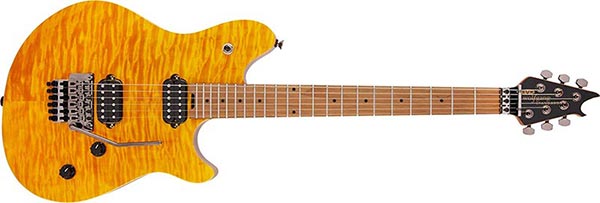
EVH Wolfgang Standard Exotic Series:
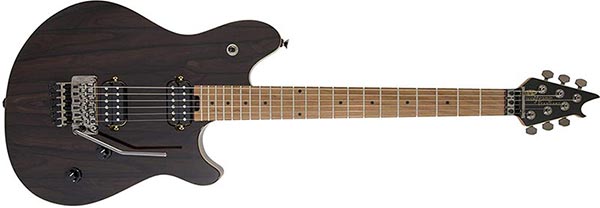
The Indonesian range of EVH guitars is limited to the budget Wolfgang options. Neither the Striped series nor the 5150 series have made it down to Indonesia as yet, although that may well occur in the future.
The Wolfgang Standard differs mostly from its Mexican and American brethren in that it lacks the EVH Bourns potentiometers. This means the “Cathedral” style volume swells facilitated by the low-friction volume pot on the USA or Special models aren’t an option on the Wolfgang Standard.
Similarly, the tuning heads are merely EVH branded, rather than the EVH-Gotoh tuning heads of the more expensive models.
One notable feature of the EVH Wolfgang Standard series is the Quilted Maple variant, which comes with a quilted maple top unavailable on the Mexican-made Wolfgang guitars.
Other than cheaper electronics and hardware, much of the Indonesian-made Wolfgang guitar is near-identical to the USA and Mexican-made guitars. This is not a slight on its more expensive brethren, but a testament to the high standards and brand reputation of EVH guitars.
The basswood body, maple neck, and EVH Wolfgang Humbucker pickups are all present in the Indonesian-made Wolfgang Standard guitars. The Wolfgang Standard even comes with an EVH branded Floyd Rose locking bridge.
Wrap Up
It’s almost unimaginable now, but once upon a time words like “shredding”, “tapping”, and “dive-bombing” weren’t in the average guitarist’s vocabulary. In the mid-1970s, rock guitar was largely derivative of the template set by Jimi Hendrix in the late sixties. Countless blues-based imitators flooded the airwaves, regurgitating BB King and Eric Clapton licks as their lives depended on it.
But then a band with a foreign-sounding name released their debut album. Track one, “Runnin’ With the Devil”, was a minor hit, but it was still hard rock as the world knew it. Track two, “Eruption”, changed everything.
“Eruption” was the world’s introduction to Edward Van Halen. The Dutch-American wunderkind with a cobbled-together guitar, searing, inimitable guitar tone, and fretboard fireworks unlike anything the world had seen before, and scarcely saw since. Over the course of one minute and forty-two seconds, Eddie Van Halen ran through a masterclass of what would become standard weapons in the shredder’s arsenal. Rapid-fire alternate picking, pitch-shifting dive bombs that sounded like a Stuka descending on a French village and, of course, his legendary guitar tapping. Often mimicked, but never matched, Eddie Van Halen changed the musical landscape forever.
It’s no surprise that the man who, faced with the guitars available in the 1970s, took a hacksaw and soldering iron to his own instrument, has his own guitar brand. If anything, it’s a greater surprise that it took so long to happen!
Eddie Van Halen was widely considered one of the greatest rock guitarists of all time. There are many who consider him the greatest of all time. His approach to the instrument was holistic, not limited merely to notes and rhythms, but a total immersion in the guitar and all its possibilities. The sound Eddie Van Halen heard in his head simply didn’t exist, so he set about inventing it.

My name is Chris and I’ve had a passion for music and guitars for as long as I can remember. I started this website with some of my friends who are musicians, music teachers, gear heads, and music enthusiasts so we could provide high-quality guitar and music-related content.
I’ve been playing guitar since I was 13 years old and am an avid collector. Amps, pedals, guitars, bass, drums, microphones, studio, and recording gear, I love it all.
I was born and raised in Western Pennsylvania. My background is in Electrical Engineering, earning a Bachelor’s degree from Youngstown State University. With my engineering experience, I’ve developed as a designer of guitar amplifiers and effects. A true passion of mine, I’ve designed, built, and repaired a wide range of guitar amps and electronics. Here at the Guitar Lobby, our aim is to share our passion for Music and gear with the rest of the music community.

You mention the Mexican-built Striped Series uses an EVH Frankenstein pickup. Do you mean the Frankenstein pickup made by Seymour Duncan? I own this guitar and recently found out they are not using the made in USA Wolfgang pickup. I’m looking for the specific pickup and have had no luck. Any help would be appreciated. Thanks !!
I wonder how they paint the Frankenstrat replicas. Surely they don’t tape and respray each one?